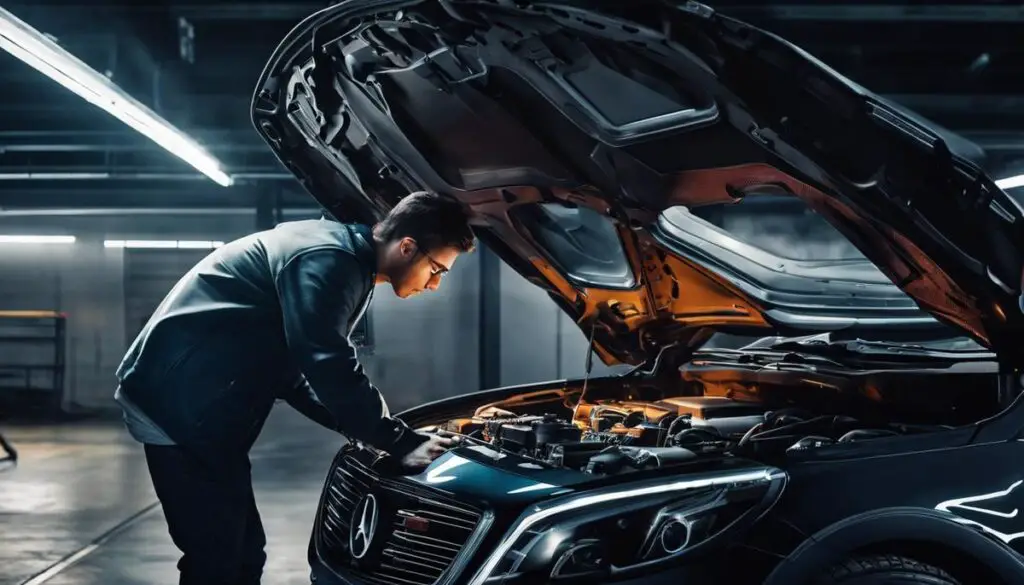When it comes to the overall performance and efficiency of your Chevy, nothing plays a more significant role than the system’s codes and signals, specifically the diagnostic trouble code, P2135. The P2135 code is a crucial one that every Chevy owner should familiarize themselves with. It’s not just about identifying the code but understanding its root causes, troubleshooting steps, and preventative measures as well. This level of comprehension is vital in maintaining the longevity and optimal functionality of your beloved Chevy.
Understanding P2135 Code
Decoding the P2135 Code in Chevy Cars: A Quick Tech Guide
There are few things as thrilling as dashing through the open road in a Chevy, yet running into a P2135 code on your vehicle’s OBD-II scanner can certainly pour cold water on the fun. To every tech enthusiast, these sort of glitches are not just obstacles, but intriguing problems begging for a tech troubleshooting solution. Let’s dive straight into what this code means, its symptoms, and the steps for rectification.
In simple terms, the P2135 code signifies an issue with the Throttle/Pedal Position Sensor/Switch ‘A’ / ‘B’ Voltage Correlation in Chevy vehicles. When this code flashes, it indicates that the voltage readings from the throttle position sensor ‘A’ and ‘B’ are inconsistent with each other. The throttle position sensor, an essential cog in the car machinery, communicates the position of the throttle to the car’s computer system, thus controlling the power within the engine. If these readings are off, the car’s performance might be significantly affected.
Understanding the reasons behind this code can offer a rich tech experience, and more often than not, it’s due to either a faulty throttle position sensor, frayed wiring in the sensor circuit, or in some instances, a glitch in the Powertrain Control Module (PCM).
Recognizing the symptoms of the P2135 code ensures immediate attention and fixing. The vehicle may enter ‘limp-home mode,’ restricting the speed to prevent engine damage. Experiencing difficulty accelerating, a decrease in fuel efficiency, or irregular idle speeds are other telltale signs. Moreover, the Check Engine Light and Traction Control Light may illuminate, signaling this specific issue.
Taking proactive steps can alleviate the problem and reduce downtime. Initially, a thorough inspection should be conducted, focusing on the wiring and connector corrosion, damage, or loose connections. If those appear fine, the next step might involve checking the PCM and sensor.
For tech enthusiasts who enjoy getting their hands dirty with DIY vehicle jobs, replacing the throttle position sensor themselves could prove rewarding. Provided necessary care is taken to prevent damaging the throttle body, disassembling the throttle body and installing a new sensor may solve the problem. It’s important to keep in mind to reset the PCM afterward to ensure accurate readings.
In certain rare circumstances, the PCM itself might be at fault. In such cases, it’s wise to consider professional technical assistance, given the intricacies involved in replacing or repairing the PCM.
Remember, staying ahead of the problem can boost overall performance, prevent potential engine issues, and ensure that there’s nothing that mars the joy of cruising in a Chevy. Crowd-sourcing solutions, staying tuned to online forums or keeping one eye firmly on the latest troubleshooting manuals can make working with technology not just fascinating but also fulfilling.

Root Causes Behind P2135 Code
Having explored the basics of P2135 code in Chevy cars, it’s importance, common causes, tell-tale symptoms, DIY fixes, and the proactive steps one ought to take, it’s worthwhile to delve deeper. Additional hidden factors may contribute to the trigger of the P2135 code, and addressing these becomes crucial to prevent repeat occurrences and the cascading damages they could bring.
Beyond the visible problems like a faulty Throttle Position Sensor (TPS) or malfunctioning Powertrain Control Module (PCM), identifying these hidden potential trigger-points becomes a key aspect in combating the P2135 engine code.
Firstly, hiccups in the electronic throttle control system (ETCS) could portray false triggers. The ETCS, functioning as the ‘communication bridge’ between your steering input and vehicle acceleration could easily miscommunicate if it suffers a glitch, thereby leading to the trigger of the P2135 code.
Though not directly linked, a malfunctioning Mass AirFlow (MAF) sensor hints at a possible cause. A critical component of the fuel-injection system, any compromise in the MAF sensor’s functionality could adversely affect the throttle position sensor, putting skewed inputs that could prompt a P2135 code.
Cutting to the chase, another under-discussed culprit is the Accelerator Pedal Position (APP) sensor. Its correlation with the throttle sensor is like two sides of the same coin. Should the APP sensor give wrong signals, the TPS misreads it, triggering the code.
Lastly, any alternations or recent modifications made to the vehicle engine, especially those involving the throttle body assembly or control systems, can trigger the P2135 code. Thus, always ensuring that installations and modifications are done accurately is vital in this context.
Recognizing these sources aids proactive diagnostics, helping tech enthusiasts and owners embrace the convenience of automation without fearing an unexpected P2135 code. With such in-depth understanding, troubleshooting becomes less of a mystery and more of a systematic journey. Technology, therefore, proves how it can always find solutions for problems it could self-create, reinforcing why tech lovers like us needn’t worry a bit when that engine light comes on.
Unmistakably, the P2135 code is not a life sentence. With the right awareness and proactivity, tech enthusiasts can quickly resolve it with a few checks and clicks. After all, technology does more than just make life better; it makes for smarter, more sure-footed drivers too.

Troubleshooting P2135 Code
Getting straight to the point, diving deep into the intricacies of the P2135 code, it’s crucial to understand the hidden factors that could contribute to its emergence. Any hiccup within the inbuilt system could be a suspect. The Electronic Throttle Control System (ETCS), for instance, plays a substantial role in maintaining engine efficiency. A malfunction in the ETCS often results in the activation of the P2135 code. In such a case, the system needs meticulous inspection to identify and rectify the malfunction.
Likewise, the Mass Air Flow (MAF) sensor measurements can also contribute to the code’s activation. In essence, the MAF sensor measures the volume and density of the air entering the engine. If it malfunctions, the Engine Control Unit (ECU) can receive incorrect data, invoking this error code. As a feasible solution, cleaning or replacing the sensor might rectify the code.
Another crucial component that can’t be overlooked in solving the P2135 code problem is the Accelerator Pedal Position (APP) sensor. This sensor transmits the position of the accelerator pedal to the ECU, which then adjusts the throttle valve accordingly. If the APP sensor readings are inaccurate or inconsistent, it might trip the P2135 code. Hence, it’s essential to check the sensor for faults and replace it if necessary.
Oddly enough, alterations or modifications to the engine can also lead to the activation of the P2135 code. Even a slight tweak can cause the code to pop up, so if there were recent modifications or repairs, it could be wise to consult with the professional who performed these modifications.
Looking holistically at these factors, understanding the unique sources of this code leads to more proactive diagnostics and problem-solving. This knowledge, in turn, results in the quicker resolution of the issue. There’s also an increased sense of personal control over one’s vehicle, as one can monitor warning signs for potential issues before they escalate.
Looking ahead, technology will continue to play an ever-important role in troubleshooting automotive issues like the P2135 code. With the advent of advanced onboard diagnostics systems and code readers, the act of diagnosing vehicle issues becomes increasingly swift and accurate. For tech enthusiasts and everyday vehicle owners alike, the promise and potential of such advancements are a testament to how far automotive technology has come — and as a glimpse into a future where autos and tech entwine even further.
In essence, untangling and solving issues leading to the activation of the P2135 code isn’t rocket science but requires a bit of insight into the tech at play and a hefty dose of proactivity. Remember, every challenge presents an opportunity for learning, and the road to mastering such tech nuances is both exciting and empowering for tech enthusiasts. This is the era to embrace automotive technology and use it to the max – because, why manually diagnose when automation can do it seamlessly?

Prevention of P2135 Code Reoccurrence
Maintaining the Flow: Combating the Recurrence of the P2135 Code Issue
The journey of troubleshooting the P2135 code doesn’t necessarily end with a single fix. Addressing the underlying trigger factors and systematically counteracting them ensures the problem doesn’t return. Let’s delve into some of these factors and smart ways to prevent code recurrence.
The Electronic Throttle Control System (ETCS), a digital system that controls throttle opening, replacing the traditional throttle cable, usually runs the show smoothly. However, any disruptions within this system can lead to code issues. Regular check-ups should include inspection of this essential machinery—cleaning of carbon deposits or replacement of faulty ETCS components may prove vital.
The role of the Mass Air Flow (MAF) sensor in maintaining engine efficiency is larger than life. It calculates the volume and density of air entering the engine to optimize combustion. Malfunctioning MAF is a common P2135 perpetrator. Periodic cleaning of the MAF sensor and its wire connectors can prevent recurrence.
The Accelerator Pedal Position (APP) sensor is the link between the driver’s foot and the ETCS. A faulty APP sensor may generate P2135 code. It is prudent to inspect, clean, or replace the APP sensor when necessary to keep code activation at bay.
Unyielding vigilance about engine alterations or modifications is integral in preventing persistent activation of the P2135 code. Modified vehicles might need specialized aftermarket sensors or specially programmed PCMs to prevent code discrepancies, which makes the user manual your new best friend.
Understanding these unique sources of the P2135 code are vital for predictive diagnostics. Adopting modern diagnostic tools equipped with artificial intelligence might just be the required upgrade in this tech-driven era, bridging the gap between the problem and solution.
Furthermore, staying aware of advancements in automotive technology and adapting them to your car can ebb future issues. Wireless software updates, digital diagnostic tools, and advanced sensor technologies can check possible problem areas before they escalate—illustrating that prevention isn’t only better but smarter than cure.
Lastly, to truly banish this issue, marry technology with good old human intuition. Maintain a meticulous record of when the code appeared, the issues that followed, and the steps taken to rectify it. This can provide insights into the pattern and help nip the problem in the bud anytime it threatens to return.
In conclusion, adopting a mix of modern diagnostic tools, sticking to routine inspections, and maintaining an instinctive, analytical approach can act as the perfect offense to prevent the recurrence of the P2135 code. The age of smart cars is upon us—let’s ride this wave smartly.

A proactive approach is key to ensure your Chevy never falls victim to the dreaded P2135 diagnostic error code. Regular maintenance, careful handling of associated parts, and early detection of symptoms are your best bet to a smooth and uninterrupted driving experience. Remember, your relationship with your vehicle is symbiotic – take care of it, and it promises to take care of your travel needs. Equip yourself with the know-how to identify, troubleshoot, and prevent issues associated with P2135; After all, knowledge empowers you to protect your investment and bolster the performance of your Chevy.

Tomas is a retired Chevy Auto Technician that brings decades of hands-on experience and expertise to the table. He’s also a father to two incredible daughters. He enjoys using his knowledge and experience to help you solve and find reliable information on Chevrolet vehicles. Whether it’s troubleshooting engine problems or providing tips for maintenance, Thomas is committed to helping Chevy owners keep their vehicles running smoothly and safely.



